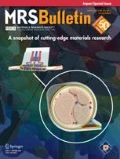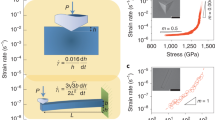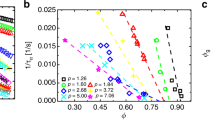Abstract
In the potential energy landscape theory of liquids, the energetic configurational landscape of a liquid is modeled using a potential energy function comprising a population of stable potential energy minima called inherent states, which represent the stable atomic configurations of the liquid. These configurations are separated by saddle points that represent barriers for configurational hopping between the inherent states. In this article, we survey recent progress in understanding metallic glass-forming liquids from a potential energy landscape perspective. Flow is modeled as activated hopping between inherent states across energy barriers that are assumed to be, on average, sinusoidal. This treatment gives rise to a functional relation between viscosity and isoconfigurational shear modulus, leading to rheological laws describing the Newtonian and non-Newtonian viscosity of metallic glass-forming liquids over a broad range of rheological behavior. High-frequency ultrasonic data gathered within the supercooled-liquid region are shown to correlate well with rheological data, thus confirming the validity of the proposed treatment. Variations in shear modulus induced either by thermal excitation or mechanical deformation can be correlated to variations in the measured stored enthalpy or equivalently to the configurational potential energy of the liquid. This shows that the elastic and rheological properties of a liquid or glass are uniquely related to the average potential energy of the occupied inherent states.
Similar content being viewed by others
References
F. Spaepen, Acta Metall. 25, 407 (1977).
A.S. Argon, Acta Metall. 27, 47 (1979).
K.M. Flores, D. Suh, R.H. Dauskardt, P. Asoka-Kumar, P.A. Sterne, R.H. Howell, J. Mater. Res. 17, 1153 (2002).
K. Hajlaoui, T. Benameur, G. Vaughan, A.R. Yavari, Scripta Mater. 51, 843 (2004).
W.L. Johnson, K. Samwer, Phys. Rev. Lett. 95, 195501 (2005).
M.L. Lind, G. Duan, W.L. Johnson, Phys. Rev. Lett. 97, 015501 (2006).
M.D. Demetriou, J.S. Harmon, M. Tao, G. Duan, K. Samwer, W.L. Johnson, Phys. Rev. Lett. 97, 065502 (2006).
F.H. Stillinger, T.A. Weber, Science 267, 1935 (1995).
P.G. Debenedetti, F.H. Stillinger, Nature 410, 259 (2001).
J. Frenkel, Z. Phys. 37, 572 (1926).
R. Busch, W.L. Johnson, Appl. Phys. Lett. 72, 2695 (1998).
J.S. Harmon, M.D. Demetriou, W.L. Johnson, Appl. Phys. Lett. 90, 131912 (2007).
J.S. Harmon, M.D. Demetriou, W.L. Johnson, Appl. Phys. Lett. 90, 171923 (2007).
C.A. Angell, J. Non-Cryst. Solids 73, 1 (1985).
H. Vogel, Z. Phys. 22, 645 (1921); G.S. Fulcher, Am. Ceram. Soc. Bull. 8, 339 (1925); G. Tammann, G. Hesse, Z. Anorg. Allg. Chem. 156, 245 (1926).
M.H. Cohen, G.S. Grest, Phys. Rev. B: Condens. Matter 20, 1077 (1979).
J.S. Harmon, PhD thesis, California Institute of Technology (2007).
G.H. Fan, H.-J. Fecht, E.J. Lavernia, Appl. Phys. Lett. 84, 487 (2004).
R. Busch, E. Bakke, W.L. Johnson, Acta Mater. 46, 4725 (1998).
J. Lu, G. Ravichandran, W.L. Johnson, Acta Mater. 51, 3429 (2003).
G. Duan, M.L. Lind, M.D. Demetriou, W.L. Johnson, W.A. Goddard III, T. Cagin, K. Samwer, Appl. Phys. Lett. 89, 151901 (2006).
M. Zink, K. Samwer, W.L. Johnson, S.G. Mayr, Phys. Rev. B: Condens. Matter 74, 012201 (2006).
A. Masuhr, T.A. Waniuk, R. Busch, W.L. Johnson, Phys. Rev. Lett. 82, 2290 (1999); K.H. Tsang, S.K. Lee, H.W. Kui, J. Appl. Phys. 70, 4837 (1991); G. Wilde, G.P. Görler, K. Jeropoulos, R. Willnecker, H.-J. Fecht, Mater. Sci. Forum 269–272, 541 (1998); Y. Kawamura, A. Inoue, Appl. Phys. Lett. 77, 1114 (2000); H.S. Chen, J. Non-Cryst. Solids 27, 257 (1978); I. Egry, G. Lohofer, I. Seyhan, S. Schneider, B. Feuerbacher, Int. J. Thermophys. 20, 1005 (1999); Y. Kawamura, T. Nakamura, H. Kato, H. Mano, A. Inoue, Mater. Sci. Eng. A 304–306, 674 (2001); T. Yamasaki, T. Tatibana, Y. Ogino, A. Inoue, in Bulk Metallic Glasses, W.L. Johnson, A. Inoue, C.T. Liu, Eds. (Mater. Res. Soc. Symp. Proc. 554, Warrendale, PA, 1999) p. 63.
Rights and permissions
About this article
Cite this article
Johnson, W.L., Demetriou, M.D., Harmon, J.S. et al. Rheology and Ultrasonic Properties of Metallic Glass-Forming Liquids: A Potential Energy Landscape Perspective. MRS Bulletin 32, 644–650 (2007). https://doi.org/10.1557/mrs2007.127
Published:
Issue Date:
DOI: https://doi.org/10.1557/mrs2007.127




